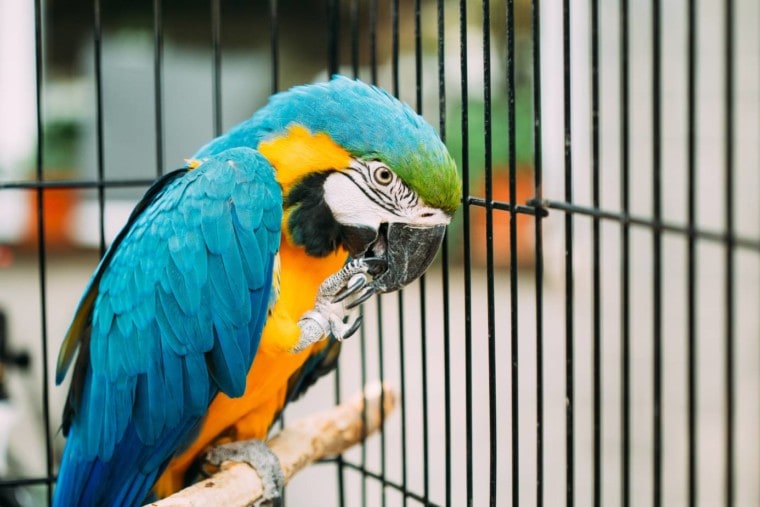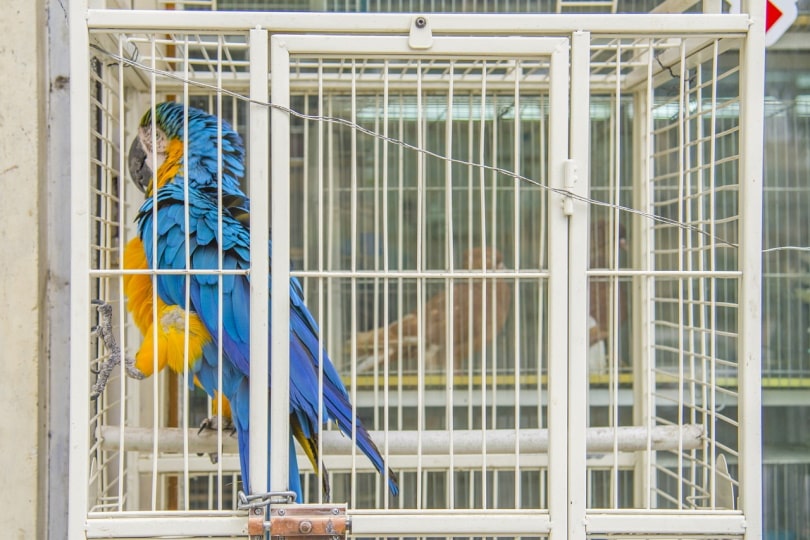
There are a variety of macaws out there! Some are the largest domesticated birds, while others are birds known as mini-macaws. The size of the cage that you need to buy depends on which type of macaw you adopt.
Larger varieties, like the Scarlet macaw, can grow up to 3 feet in length. They need an enclosure that will encompass not only their massive size but also their tails, which alone can be more than half their entire length.
Not only do macaws need plenty of space for themselves, but they are also highly social creatures. The recommendation is often to have birds in pairs, although two birds will need an even bigger cage to fit them.
There are also smaller macaws, like Hahn’s macaw, that need less space but will be happier with more interior room.
Choosing the Perfect Macaw Cage
The interior space of the cage for your macaw is the most critical factor. You must make plenty of room for it in your home and get the largest birdcage that you can afford. Macaws are not birds that will go unnoticed and will need a substantial amount of space to stay healthy.

Sizing Your Macaw’s Cage
Providing a specific recommendation for the cage’s size that fits all birds in this species is difficult. Instead, use the guideline that any enclosure you get should allow the bird enough space to expand their wings and flap freely.
In other words, for small species of macaws, check out cages that are at least 34 inches wide, 24 inches deep, and 36 inches tall. This gives them enough room to move around, play, extend their wings, and keep their tails inside the enclosure.
For larger macaws, you want to almost double this. The minimum cage size for these species should be 36 inches wide, 48 inches deep, and 60 inches tall. For most parrots, the height of the cage doesn’t matter as much. However, having a cramped tail for too long can cause health and balance issues for a large macaw.

Safeguarding the Cage for Your Macaw
Macaws have adapted in the wild to eat various nuts, seeds, berries, and fruits. They need a higher level of fat than many other birds seem to. Thus, seeds and nuts are important parts of their diet.
Their beaks have adapted over time to make it easier for them to eat these kinds of foods with ease. They can use their large, strong beak to snap into a nut or a difficult seed and get to the fatty meat inside. Even though they shouldn’t have to do as much of this to survive as a house pet, they still have that strong beak. Their cage needs to have strong wire bars so it doesn’t bend or break under duress from their beak. They rely on their beaks to help them climb around their enclosures. Rusty or broken wires can puncture their skin and be detrimental to their health.
For small macaw species, find a cage with bar spacing at about ¾ of an inch to 1 inch apart. For larger macaws, find an enclosure with bars spaced 1 to 1.5 inches apart.
Beyond the bar spacing, keep in mind that a parrot as intelligent as a macaw will use their ingenuity to figure out how to open their doors. Ensure that the cage is equipped with locking mechanisms, so they do not escape when you are not around and get into danger.
- Related Read: Can Two Macaws Live Together in the Same Cage?
Additional Features
The cage also needs to be big enough to hold the bird and any toys inside. Without having things to play with and keep them occupied, macaws quickly develop destructive behaviors, like feather picking.
Having enough toys inside of your macaw’s cage is how to keep them occupied, content, and alert. They enjoy being entertained and can play for a long time with very little. But they should get a wide variety of toys, which should get rotated periodically to keep them fresh.
Think of what their life would be like in the wild. They could easily fly around from place to place to get additional mental stimulation and find new things to play with when they got bored. They rarely would have done the same thing twice.
Creating a space that is the most similar to what their life would be like in real life is one of the better ways to keep them happy and healthy.
Another feature to consider when buying their cage is a “play top” cage. This allows the top to be opened and a perch placed in the center or to the side. Then, your macaw can fly out of the top of the cage or hang out on that perch.
These kinds of cages give them increased accessibility to the home while still keeping them safe. It also gives them the capacity to remain in an area where they feel more comfortable.
- You may also be interested in: Hahn’s Macaw
Final Thoughts
There are a lot of consideration to mull over when getting the right cage for your macaw. A bird this size will not thrive in a cage that does suit its needs. All birds need enclosures that keep them comfortable, safe, and security. Happy shopping!
Featured Image: Gisha Bruev, Shutterstock









